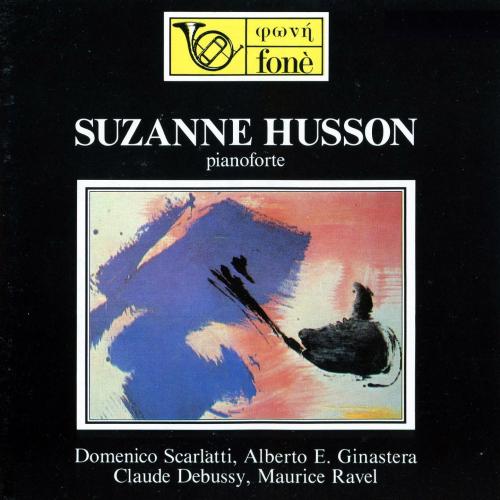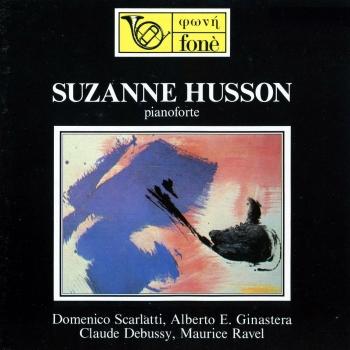
Scarlatti, Ginastera, Debussy, Ravel (Remastered) Suzanne Husson
Album info
Album-Release:
1987
HRA-Release:
22.02.2023
Label: fonè Records
Genre: Classical
Subgenre: Instrumental
Artist: Suzanne Husson
Composer: Alessandro Scarlatti (1685-1757), Alberto Ginastera (1916-1983), Claude Debussy 1862-1918), Maurice Ravel (1875-1937)
Album including Album cover Booklet (PDF)
- Domenico Scarlatti (1685 - 1757): Sonata in mi maggiore K. 20:
- 1 Scarlatti: Sonata in mi maggiore K. 20 03:03
- Sonata (Toccata) in re minore K. 141:
- 2 Scarlatti: Sonata (Toccata) in re minore K. 141 04:28
- Alberto E. Ginastera (1916 - 1983): Danzas Argentinas, op. 2:
- 3 Ginastera: Danzas Argentinas, op. 2, I. Danze del viejo boyero 01:37
- 4 Ginastera: Danzas Argentinas, op. 2, II. Danza de la monza donosa 03:05
- 5 Ginastera: Danzas Argentinas, op. 2, III. Danza del gaucho matrero 02:56
- Claude Debussy (1862 - 1918): Estampes:
- 6 Debussy: Estampes, 1. Pagodes 04:37
- 7 Debussy. Estampes, 2. Soirées dans Grenade 05:20
- 8 Debussy: Estampes, 3. Jardins sous la pluie 03:33
- Maurice Ravel (1875 - 1937): Gaspard de la nuit (Trois poèmes pour piano d’après Aloysius Bertrand):
- 9 Ravel: Gaspard de la nuit (Trois poèmes pour piano d’après Aloysius Bertrand), 1. Ondine (lent) 06:23
- 10 Ravel: Gaspard de la nuit (Trois poèmes pour piano d’après Aloysius Bertrand), 2. Le Gibet (très lent) 05:14
- 11 Ravel: Gaspard de la nuit (Trois poèmes pour piano d’après Aloysius Bertrand), 3. Scarbo (modéré) 10:07
- Jeux d’eaux:
- 12 Ravel: Jeux d’eaux 05:44
Info for Scarlatti, Ginastera, Debussy, Ravel (Remastered)
The richness and incredible flexibility of Domenico Scarlatt1's sonatas make classification impossible. All the formal elements, with their free articulation which often predict the works of classical composers are proof of the musician 's genius. The developmental are of the Scarlattian Sonata is projected with an astonishingly inventive variety. The changing modulations are audacious, and almost always, after the recapitulation, the composer offers us new material or a free improvisation on the original theme. Scarlatti's position is that of a composer who, in contrast to his predecessors who practised progression and sequence, not only reveals an elaborate thematic inlay, but also a profound and thought-out conception of the phenomenon of sound. Scarlatti's harmonies are innovative be it for the colouristic function of the modulations, or for the expressive intensity of the dramatic resolutions. Scarlatti's sonatas defy any rationalization and reflect the spirit of a musician who found, in the bizarre, in the p1cturesque, and in virtuosic finger-work, those elements which are fundamental to his works. Dance movements are also suggested in the sonatas, not as objective models, but as echoes and reminiscences of Spanish folklore which seer from the stitches and inter-weaving of the sonoric texture. Polyrhythm and abrupt rhythmic interruptions are other characteristics of Scarlatti's musical language, and they not only indicate the modernity and open-mindedness of the composer, but also his vivid imagination. Even though he lived in an era of crisis Scarlatti remained immune to it. Rather than his isolation resulting in a sense of inferiority or inadequacy, he drew from it a strength and spiritual energy that set him far above most of his contemporaries. In short, he lived through and overcame his crisis by way of the fantastic game of creation and his artistic intuition and foresight. His work ss exempt from any heavy debris and fatuousness; it does not reflect the limits dictated by the age, but rather stretches out, with prestigious security, along the road open to future generations.
Suzanne Husson, piano
Digitally remastered
Suzanne Husson
"Two phenomenal hands!" - this is the way in which the famous pianist Arturo Benedetti Michelangeli described Suzanne Husson, who is considered by international critics to be one of the foremost interpreters today. She was born in Buenos Aires, to French parents, and now lives in Geneva. Suzanne Husson began her musical studies when she was five, under the guidance of Elisabeth Westerkamp de Rathe (a student of the famous professor Scaramuzza) at the Conservatory "Manuel de Falla" in the Argentinian capital. She gave her first public concert when she was 8. She moved to Europe to specialize mainly with Arturo Benedetti Michelangeli, Luis Hiltbrand, Bruno Seidlhofer, Nikita Magaloff and Carloz Zecchi. She has won first prize at the "Argentinian Mozarteum” , first prize or virtuosity 'with distinction at the Geneva Conservatory and a prize in the Josef Pembaur Foundation competition in Bern. She has been awarded distinction on at competitions in Geneva Vercelli, ~Barcelona’s ''Maria Canal"(forthe bestinterpretation of Spanish music), Lisbon's "Vianna da Motta" Paris' "Magda Tagliaferro" (special R. Juilliard prize). She has performed on television and on radio, at important festivals, in concert halls at recitals and as a soloist (in Europe, the United States of North America and South America), often premiering new works. She has played with the violinist Patrice Fontanarosa, with Vienna 's Musikverein-Quartet andunder the direction of conductors such as Charles Dutoit, Armin Jordan, Horst Stein and Wolfgang Sawallisch with whom she made her most recent record. Versatility and perspicacity supported by brilliantvirtuosity are the characteristics which make up Suzanne Husson's artistic personality. Her vast repertoire which includes both classical and modem music, is not purely a matter of quantity, but rather a reflection of her own carefully thought-out choice.
Booklet for Scarlatti, Ginastera, Debussy, Ravel (Remastered)










